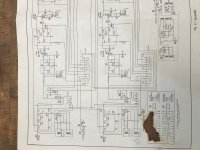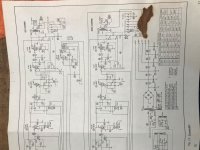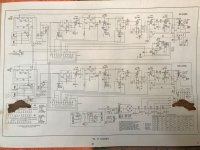SE 7591 Stereo Amplifier Project
I picked up an old stereo reel to reel with the intention of restoring it but after close examination, decided my time would be better spent building something useful to help me learn more about how tube amps work. The built-in stereo amplifier works and uses one 7591 tube and two 6EU7 tubes per channel, the rectifier is a 6C4. I'm thinking to remove the transformers and mount them in new chassis.
1) can the power amplifier be replicated per the schematic or should I start fresh?
2) are there any other components that can be re-used?
3) is this a feasible project?
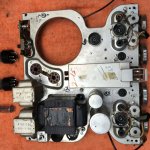
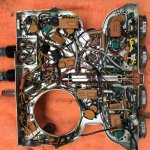
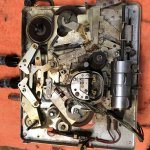
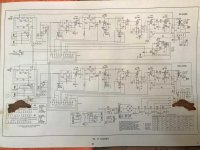
I picked up an old stereo reel to reel with the intention of restoring it but after close examination, decided my time would be better spent building something useful to help me learn more about how tube amps work. The built-in stereo amplifier works and uses one 7591 tube and two 6EU7 tubes per channel, the rectifier is a 6C4. I'm thinking to remove the transformers and mount them in new chassis.
1) can the power amplifier be replicated per the schematic or should I start fresh?
2) are there any other components that can be re-used?
3) is this a feasible project?




Attachments
Last edited:
Unfortunately, the power transformer may be the only magnetic worth salvaging. Full pentode mode without loop NFB of some kind SUCKS. I see full pentode mode without NFB in the schematic. 🙁 Perhaps short loop NFB, AKA Schade, would allow recycling of the O/P "iron". I highly doubt the magnetic headroom needed to support a global NFB loop is present.
The triodes in the 6EU7 are the same as those in the 12AX7. If the tubes you possess are strong, they might fetch a few coins. The 6EU7 contains a spiral wound, hum bucking, heater and that feature is not needed at "line" level.
The 7591 is as easy to drive as a 6BQ5/EL84. If a CDP is the signal source, a single 12AX7 section will provide sufficient voltage amplification.
The triodes in the 6EU7 are the same as those in the 12AX7. If the tubes you possess are strong, they might fetch a few coins. The 6EU7 contains a spiral wound, hum bucking, heater and that feature is not needed at "line" level.
The 7591 is as easy to drive as a 6BQ5/EL84. If a CDP is the signal source, a single 12AX7 section will provide sufficient voltage amplification.
The feedback is from the output plate to the driver cathode; it keeps the OPT out of the loop (like Schade) but includes the driver (unlike Schade). Should work fine - one 6EU7 and two 7591s for a stereo amp.
(I notice the 6C4 is the tape bias oscillator, not rectifier - the power supply uses solid-state rectification.)
I don't know what that neon bulb is doing in the feedback loop, though!
(I notice the 6C4 is the tape bias oscillator, not rectifier - the power supply uses solid-state rectification.)
I don't know what that neon bulb is doing in the feedback loop, though!
The power amplifier, as is, has a lot of frequency shaping RC networks wrapped around it, appropriate for its intended use within a tape deck and driving a specific pair of speakers.
For general, "hi-fi", use you'd want to remove all that stuff and make a "flat" amplifier. You have plenty of parts to make a nice coupla-Watts per channel amplifier on a new chassis.
I'd suggest thinking about rebuilding the power supply, with modern safety considerations, and reusing the output valves, connected as triodes, and one of your 6EU7s as the driver for both channels. The output transformers will be fine as is. Could easily be a very nice amplifier when pared down to fighting weight.
All good fortune,
Chris
For general, "hi-fi", use you'd want to remove all that stuff and make a "flat" amplifier. You have plenty of parts to make a nice coupla-Watts per channel amplifier on a new chassis.
I'd suggest thinking about rebuilding the power supply, with modern safety considerations, and reusing the output valves, connected as triodes, and one of your 6EU7s as the driver for both channels. The output transformers will be fine as is. Could easily be a very nice amplifier when pared down to fighting weight.
All good fortune,
Chris
Thank you all for the responses. I'm not expecting a high quality amp from this project but looking at it more as a learning experience. I'm going to go ahead and remove the transformers and take their measurements which I'm assuming would be the place to start.
I see only 3 capacitors in the amp circuit itself:The power amplifier, as is, has a lot of frequency shaping RC networks wrapped around it, appropriate for its intended use within a tape deck and driving a specific pair of speakers.
...
Chris
0.05uF interstage coupling; rolls off the bass below about 6Hz.
0.033uF in the feedback; boosts the bass below about 85Hz but is likely to also provide stability to the loop to prevent motorboating.
47pF in the feedback; rolls off the treble at around 35kHz but probably also provides stability to the loop to prevent high frequency oscillation.
If you are copying the design, I wouldn't mess with any of them, at least initially.
I don't know what that neon bulb is doing in the feedback loop, though!
If you trace the feedback from 2nd plate to 1st cathode, it goes directly through the two compensation capacitors (HF and LF). If some idiot were to disconnect the speaker under load the voltage spike at the 7591 pate can go uncontrolled. The neon bulb should clamp it preventing too much voltage from hitting the 6EU7 cathode. If it degrades the h-k insulation you can get a hummmm which is at a minimum, annoying.
I've also considered using the 7591 in SE because, as Eli pointed out, it's so easy to drive, like a 6BQ5 / EL84.
As a beam pentode the 7591 is rated at 11w in Class A (SE) but the data sheet says that's with 13% distortion. Does anyone know the power output at, say, 5% or less?
In PP the data sheets show power outputs, depending on configuration, between 23w and 45w, which is considerably more power than a 6BQ5 / EL84 in PP, and the distortion is only 1.5% or 2%. but I wonder if there's really much power difference in SE when measured at the same % of distortion.
I've also never seen any data for it in triode, other than the plate curves. What's the power output in triode and at what % of distortion? If you're going to use it in triode and SE, I'm wondering if there is any advantage to using the 7591 (or the equivalent 7868) over a 6BQ5?
As a beam pentode the 7591 is rated at 11w in Class A (SE) but the data sheet says that's with 13% distortion. Does anyone know the power output at, say, 5% or less?
In PP the data sheets show power outputs, depending on configuration, between 23w and 45w, which is considerably more power than a 6BQ5 / EL84 in PP, and the distortion is only 1.5% or 2%. but I wonder if there's really much power difference in SE when measured at the same % of distortion.
I've also never seen any data for it in triode, other than the plate curves. What's the power output in triode and at what % of distortion? If you're going to use it in triode and SE, I'm wondering if there is any advantage to using the 7591 (or the equivalent 7868) over a 6BQ5?
I'm wondering if there is any advantage to using the 7591 (or the equivalent 7868) over a 6BQ5?
Some good higher mu output tubes with dissipation around 18W or more in triode are these:
EL12
EL12n
EL38
F2A
7591 (I've not used this so speculating...)
Beefier than EL84 in triode, which is equivalent to EL33, EL11, KT61 and other lower output tubes. All nice, of course.
Thanks Andy. All nice tubes I'm sure but availability / price in the US might be an issue. I have some old production 7591 / 7868 and EL84 in stock and both of these are also available in new production.Some good higher mu output tubes with dissipation around 18W or more in triode are these:
EL12
EL12n
EL38
F2A
7591 (I've not used this so speculating...)
Beefier than EL84 in triode, which is equivalent to EL33, EL11, KT61 and other lower output tubes. All nice, of course.
Perhaps someone who's experienced with the 7591 / 7868 can answer the questions I posed.
As I've mentioned elsewhere, I'm using another easy to drive tube, the 6N6G, in my current project with a 26 as input tube. It's a dual, dissimilar triode. While the 6N6G is not currently produced, it doesn't seem to be particularly rare and prices for NOS are in the same range as new production 7591s and sometimes cheaper. It's definitely an oddball, under the radar, tube. Depending on the plate voltage used, it's rated at 4w to 5.2w at 5% distortion.
So I'm curious about the 7591's output at similar distortion levels. I suspect the 11w pentode output of the 7591 (at 13% distortion) is quite a bit lower at 5%. And I've been unable to find any power output rating for it in triode, but it would obviously be even lower. But how low? And how does it compare to the more common EL84 / 6BQ5?
I have several vintage PP amps that use the 7591 and they sound great. It's a wonderful tube but it seems like it's rarely used in SE, where the EL84 is much more common.
It does make me wonder why they chose a 7591 here with just a 280 volt supply. Not going to get any 11 watts for sure, regardless of distortion. An EL84 would have been fine - it seems to me that 7591’s were designed with push pull operation into high Z loads, with a higher B+ in mind.
I have a early 60's Westinghouse SE 7591 amp I got from a ratty old console many years ago. Uses a single 12AX7 driver. Still has original Westinghouse tubes.
- Home
- Amplifiers
- Tubes / Valves
- SE 7591 Amp Project
